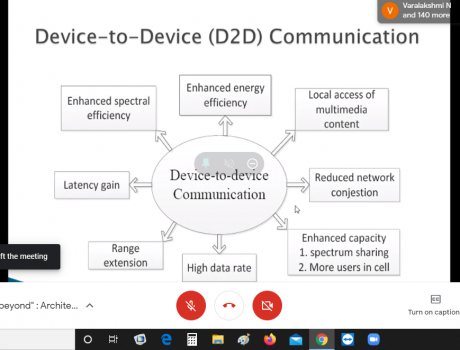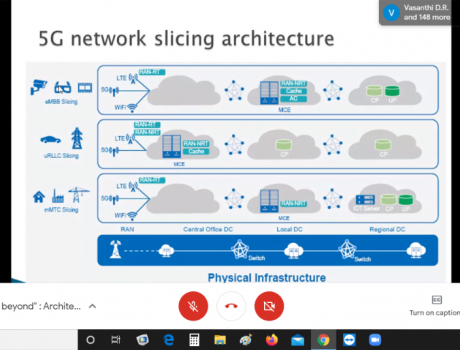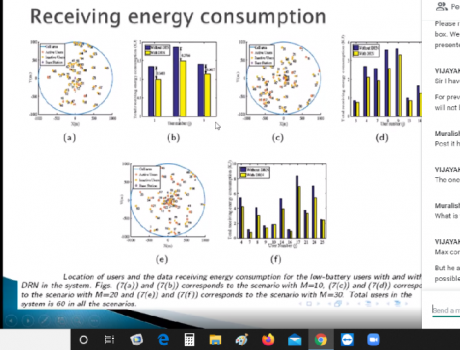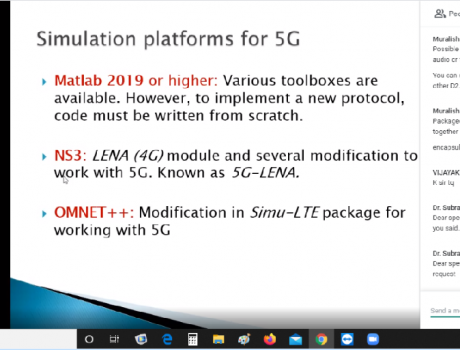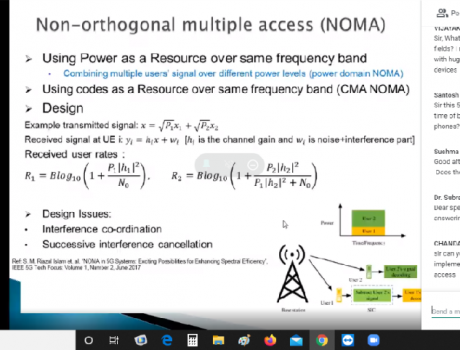“Device-to-Device Communication in “5G and Beyond”: Architecture, Features, Challenges and Future Research Directions”
Name of the Webinar: Device-to-Device Communication in “5G and Beyond”: Architecture, Features, Challenges and Future Research Directions
Hosted by: School of Engineering and Technology, CMR University
Date and Time: May 16, 2020 from 10:00 A.M. to 11:30 A.M (Planned), but actual programme happened from 9.45 A.M. to 12.45 P.M. The recorded actual session is from 9.45 A.M. to 12.45 A.M.
Total no. of Participants: 198.
Speaker: Pradip Kumar Barik. (Senior Research Scholar, Network Lab, IIT Kharagpur)
Organized by: Dept. of Electronics and Communication Engineering, SoET, CMR University.
Platform: Google Meet
Details of Meeting ID: Saturday, May 16, 2020 10:00 am | 1 hour 30 minutes | (UTC+05:30) Chennai, Kolkata, Mumbai, New Delhi
Join by phone +1 804-803-5061 (PIN: 283389716)
Link: meet.google.com/qog-qqdd-ajd
| Introduction |
The document on hand is a narration of the detail the proceedings of the webinar on Device-to-Device Communication in “5G and Beyond”: Architecture, Features, Challenges and Future Research Directions, that was hosted by Dept. of Electronics and Communication Engineering, SoET, CMR University. The webinar was conducted on Google Meet platform and it was organized for students and faculties of various Engineering colleges.
| Webinar Objectives: |
The main objective of this webinar was to cover the basic architecture and components of 5G, to discuss the major differences between 4G and 5G (w.r.to architecture and features) for students, faculties and research scholars of various Engineering colleges during Covid-19 lockdown.
The concept of D2D communication, its challenges and solution approach of a resource allocation problem was discussed subsequently. Finally, the webinar concluded with some future research problems in “5G and beyond” mobile networks.
| About the Speaker |
Mr. Pradip Kumar Barik received the B.Tech degree in Electronics and Communication engineering from Kalyani Govt. Engg. College, West Bengal, India in 2012 and M.Tech degree in Communication Engineering from NITK Surathkal in 2014. He is a Gold Medallist from NITK Surathkal. He was with Broadcom India PVT LTD as system design engineer in Cellular Protocol Development and Testing division and Assistant professor at CMRIT, Bangalore. He is currently pursuing the PhD degree from E&ECE department, IIT Kharagpur. His current research interest includes adaptive multimedia services over heterogeneous 5G cellular networks, cross-layer optimization in wireless networks, resource allocation for D2D and M2M communication, and machine learning for wireless communication. He has both journal and conference publications namely, in Elsevier Computer Communications and other IEEE conferences. Recently, his paper was accepted for publication in IEEE transaction on vehicular technology.
| Webinar proceedings – In brief. |
5G mobile communication system is supposed to provide a perception of 99.99% connectivity. The essential requirements of 5G are higher throughput, enormous capability, energy efficient transmission, ultra-low latency, and support of rich multimedia applications. 5G cellular network has been tremendously used in automated vehicles, IoT applications, video streaming, mobile TV etc. To provide seamless connectivity, higher spectral and energy efficiency, device-to-device (D2D) communication has become a key technology in 5G. D2D communication helps in meeting various requirements of 5G. However, there are several challenges such as proper resource allocation, mode selection, device discovery, and mobility in D2D enabled 5G networks.
The event started at 10.00A.M with a welcome speech by Dr. Satheesha T.Y, Head, Dept. of Electronics and Communication. He welcomed the speaker of the event Mr. Pradip Kumar Barik, Honourable Pro-Vice Chancellor Dr. Suresh K.S, CMR University, Honourable Registrar Dr. Praveen R., CMR University, Dr. Jayaprasad M., Dean, School of Engineering and Technology, CMR University, Faculties and participants of the event.
The Honourable Pro-Vice Chancellor Dr. Suresh K.S addressed the participants with his inspirational words and briefed the importance this webinar during Covid-19 lockdown situation.
The Honourable Registrar Dr. Praveen R addressed the participants with his inspirational words and added a special mention to department of ECE for launching a wonderful program during this lockdown period.
Dr. Jayaprasad M., Dean, School of Engineering and Technology, motivated the participants by briefing the prominence of 5G in current technology.
Dr. Muralishankar R. Professor, Dept. of Electronics and Communication, who is the pioneer in organizing this event, briefed about the webinar to the participants and its significance.
The session was auspiciously started with an invocation song by Prof. Divyashree, Assistant Professor, Dept. of Electronics and Communication Engineering.
The speaker started his session by introducing the evolution of 5G. The basic differences between 4G and 5G architecture and features were discussed.
The webinar also included a discussion on the need of a new technology. The different applications of this new technology were discussed. The disadvantages of mmwave were discussed in detail..
The webinar also included key take way concepts such as channel models in 5G and signal to interference noise ratio (SINR). The simulation of SINR which was published by the presenter in one of his papers were shown and the explanation about the comparison of 4G and 5G SNR was given.
The participants were also introduced to LTE (4G) architecture and 5G architecture to bring out the main advantages of 5G over 4G. The presenter included two videos to show the difference between 4G and 5G technology which explained the comparison in more detail. Further, the session included the concepts such as efficiency, complexity and latency comparison between the two generations.
The types of D2D communication were outlined with the block diagram. The applications of D2D communication in 5G were discussed. The participants were introduced to a battery energy consumption model for active CUs and active DRNs. The results of his paper such as battery drainage of the users, receiving energy consumption, saved battery energy of the active CUs, saved transmission power of the base station, number of unserved users and comparison of energy efficiency were displayed and explained in detail.
In the end the discussion moved to the future research directions, the open issues in D2D communications, the challenges.
At the end of the session, the speaker addressed various questions from the participants on the topic of the webinar in Q&A session.
The webinar was concluded with vote of thanks by Prof. Swetha Vura, Assistant Professor, Dept. of Electronics and Communication.
